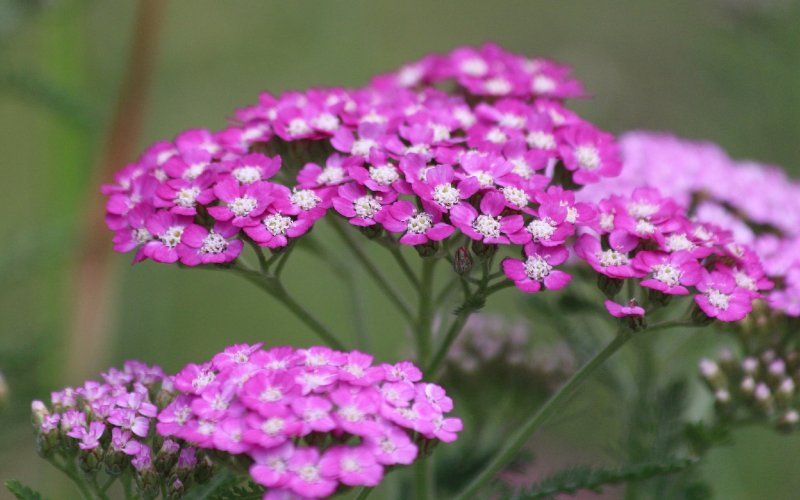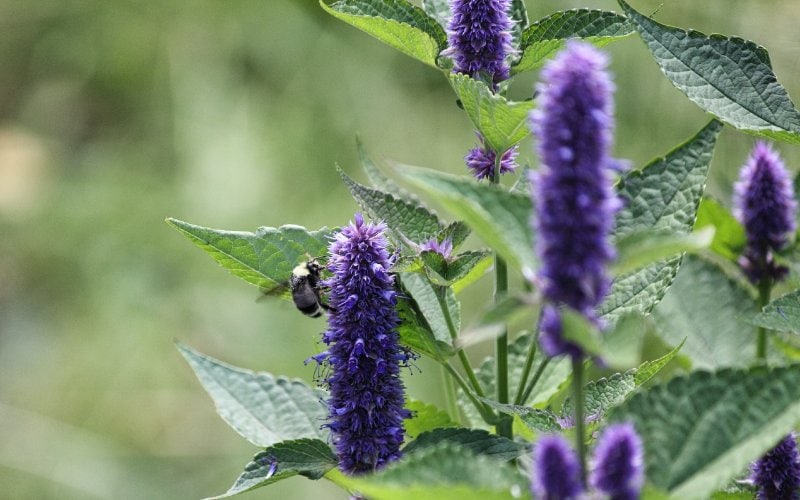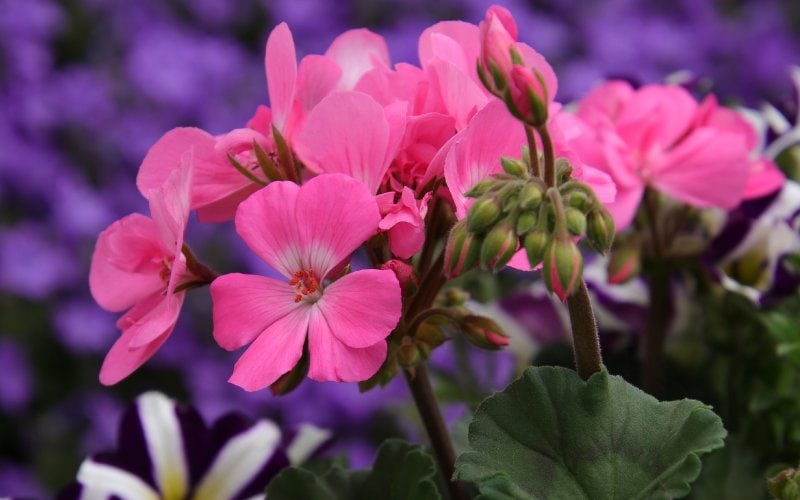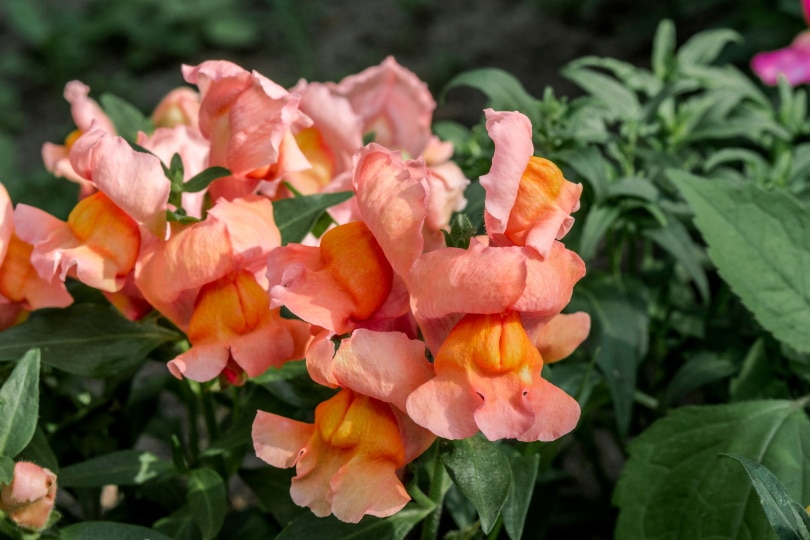25 Companion Plants for Dahlias (With Pictures)
-
Pete Ortiz
- Last updated:

Dahlias are perennial flowers that can bloom in summer and right through to fall. They like rich, slightly acidic soil that is moist but drains well. Finding the best companion plants means finding those that will benefit from the same growing conditions but bring something extra to the look of your planting.
The staggering selection of colors and choices of dahlias means that you could fill your garden with this variety of plant alone. However, that incredible choice also means that there is a wide range of plants to match the style of your Dahlias, as well as those that contrast and oppose the flowers.
Below, you will find 25 companion plants for Dahlias in containers and in your garden so that you can create a stunning and thriving outdoor space.
The 25 Companion Plants for Dahlias
1. Achilleas

| Latin Name: | Achillea |
Also known as yarrows, achilleas are recognized for their feathery foliage. Colors range from white to pink, and as well as being popular in wildlife gardens, they can also bring a little wild planting to an otherwise formal garden. Although they tolerate partial shade, achilleas prefer full sun and can be grown in gravel gardens.
2. Lily of the Nile

| Latin Name: | Agapanthus |
Also known as African lily, lily of the niles are easy to grow and result in an exotic, wild-looking perennial. These do better in partial shade and prefer well-drained acidic soil, so they should grow alongside dahlias.
3. Giant Allium

| Latin Name: | Allium |
The allium family of plants includes edibles like garlic and onion but also a wide variety of ornamental flowering plants. The flowers are usually purple and while some only grow to a few inches, the giant allium can grow to 2x-3 feet high. Giant alliums flower in late spring and as their show is over, your dahlias will be starting to blossom.
4. Amaranthus

| Latin Name: | Amaranthus |
There are a lot of different varieties of amaranthus to choose from, including short and tall varieties. The species have a wild look about them, and colors do vary but tend towards purple. Many varieties of amaranthus are edible and almost all prefer soil that drains well but never gets completely dry.
5. Anise Hyssop

| Latin Name: | Agastache Foeniculum |
Anise hyssop is a colorful plant that grows in full sun and flowers in summer. It can reach up to 4 feet and spread up to 3 feet, so it may take some management to ensure it doesn’t encroach on your Dahlia planting.
As well as looking great, the leaves and the flowers of anise hyssop are edible and have a mild licorice flavor. It also directly repels aphids while attracting wasps that help further control aphid numbers.
6. Artemisia

| Latin Name: | Artemisia |
There are several hundred varieties of artemisia and is a plant that belongs to the daisy family. It has stunning lacy foliage and is very effective at deterring slugs, so if you’re having a problem with your dahlias being decimated by these slimy pests, artemisia offers an attractive solution.
7. Aster

| Latin Name: | Aster |
Aster, which means star in Latin, gets its name from its star-shaped flowers. It has a daisy-like flower head, and the pink or purple blooms look very effective when planted as a canvas that enables your dahlias to shine.
8. Bee Balm

| Latin Name: | Monarda didyma |
Also known as oswego tea or bergamot, bee balm typically grows on damp ground and by streams and has pink, red, or purple firework-like flowers. The plants grow tall, up to 5 feet, but their stems are strong enough to hold them. It gets its common name from the fact that it is attractive to bees and some other pollinators.
9. Black-Eyed Susan

| Latin Name: | Rudbeckia Hirta |
Black-eyed Susan is a brilliantly colorful plant with bright yellow, orange, or red petals and a dark brown center that looks almost black. It enjoys full sun and grows to 3 feet tall. It is heat and drought-tolerant, which makes it a good choice for gardens in hot climates.
10. Blazing Star

| Latin Name: | Liatris spicata |
Blazing star has flower spikes that bloom in late summer and fall. Although it can reach a height of four feet, it typically only spreads about one foot, which makes it good for precise planting between your dahlias or to bookmark them. Alternatively, you can mix blazing stars and dahlias to offer vertical excitement.
11. Common Switchgrass

| Latin Name: | Panicum Virgatum |
Common switchgrass is an ornamental grass. It will grow in partial shade but prefers full sun. It grows to 6 feet tall and 2 feet wide and has a touch of pink atop the narrow grass. It can act as a backdrop to colorful dahlias.
12. Coneflower

| Latin Name: | Echinacea |
Coneflower, or echinacea, has a similar appearance to that of the daisy and comes in a good variety of colors. They have a colored center that is ball-shaped and bold. Echinacea is not only an attractive flower but is also prized as a supplement for its antibacterial properties.
13. Cosmos

| Latin Name: | Cosmos |
Available in a range of colors, including bi-color examples, the cosmos enjoys full sun and works especially well in wild gardens and wild beds. Depending on the variety, it can reach 6 feet tall, although smaller varieties only reach 1–2 feet.
14. Crocosmia

| Latin Name: | Crocosmia Pottsii |
Crocosmias enjoy full sun but will tolerate partial shade and have fiery orange-red flowers. Its leaves look like fronds, giving a dramatic look, and they grow to approximately 3 feet tall and 1 foot wide, looking especially effective when interspersed with your dahlias.
15. Floss Flower

| Latin Name: | Ageratum Houstonianum |
The floss flower likes full sun or partial shade and grows to 2 feet tall and 1 foot wide with blue, pink, white, or red flowers. These flowers are good at attracting pollinators, and they are especially popular for picking and using in bouquets.
16. Lantana

| Latin Name: | Lantana Camara |
Lantana can be perennial or annual, depending on your climate, and, like the dahlia, its blooms will last from summer to fall. Choose a variety according to the color of the bloom and plant at the front of your dahlia bed because lantana grows to 1 foot in height and 1 foot wide.
17. Nicotiana

| Latin Name: | Nicotiana |
Nicotiana, or tobacco plants, offer a rich aroma that dahlias lack. It is an annual plant, and you will need to choose species carefully to ensure that you do get a scented one. Perfume purple is a popular choice and, as well as being fragrant, it has pretty purple flowers.
18. Pelargonium

| Latin Name: | Pelargonium |
Pelargonium is an annual or perennial, depending on the climate zone, and is also known as regal geranium or scented geranium. The stems of the pelargonium can reach heights of 4 feet, making this a good choice for planting behind your dahlias. Choose from the selection of pink, red, purple, white, or yellow flowers.
19. Pennisetum

| Latin Name: | Pennisetum Setaceum |
Pennisetum is an ornamental grass that grows well in warm climates. It will reach its peak just as your dahlias are blossoming, and the combination can be very impressive. There are different varieties, some of which, like the red head variety, offer plenty of color as well as stature.
20. Rosemary

| Latin Name: | Salvia Rosmarinus |
Rosemary is a popular herbaceous plant that is usually grown for its aromatic and tasty properties. However, if you leave the herb to grow, it has pretty spikes of colorful blossoms. It can grow to 6 feet tall making it a beautiful backdrop for your dahlias, and its natural scent will emerge when the wind blows.
21. Snapdragon

| Latin Name: | Antirrhinum Majus |
Growing either as a perennial or annual, depending on climate, the snapdragon is a popular garden ornamental thanks to its two-lipped flowers. Snapdragons can grow to 3 feet tall, and you will be able to enjoy the pretty flowers in spring and fall.
22. Sneezeweed

| Latin Name: | Helenium Autumnale |
The daisy-like sneezeweed is a perennial that can grow to 5 feet tall with a bright and colorful bloom. Its flowers make it the perfect fit for a meadow garden, and the plant gets its name because the dried leaves were used to make snuff—its inhalation would cause users to sneeze and rid the body of evil spirits.
23. Turtlehead

| Latin Name: | Chelone Obliqua |
Turtleheads look similar to snapdragons and have the appearance of a turtle head popping out from the top of the plant. They grow in full sun or partial shade and come in white, pink, or purple so can match or contrast your dahlias, as required. They grow to approximately 3 feet tall.
24. Verbena

| Latin Name: | Verbena |
Verbena grows in hot and tropical climates and can be found growing on roadsides and other areas. It is quite woody and has heads of small, delicate flowers. The stems, leaves, and flowers are used to make supplements that can be used to treat congestion and gingivitis.
25. Zinnia

| Latin Name: | Zinnia |
Zinnia can grow in a good range of climates and conditions, although it benefits from being subjected to full sun. It comes in a host of colors, typically growing to less than a foot in height, so it can be mixed with dahlias or grown in front of them.
Conclusion
Dahlias are bright and colorful, come in a variety of sizes and hues, and they are strong and varied enough that it is possible to create an entire garden using nothing but. However, combining them with matching or contrasting plants, including ornamental grasses and some herbs, is a great way to make the most of them.
- 19 of the Best Flowering Companion Plants for Dahlias | Gardener’s Path
- What To Grow with Dahlias | BBC Gardeners World Magazine
- Dahlia Plant Companions: Learn About Companions For Dahlia In The Garden
- How to Grow Amaranthus | BBC Gardeners World Magazine
- How to Grow Achilleas – gardenersworld.com | BBC Gardeners World Magazine
- Learn How To Plant, Care and Grow Bountiful Agapanthus
- All About Alliums
Featured Image Credit: Timo C. Dinger, Unsplash
Contents


